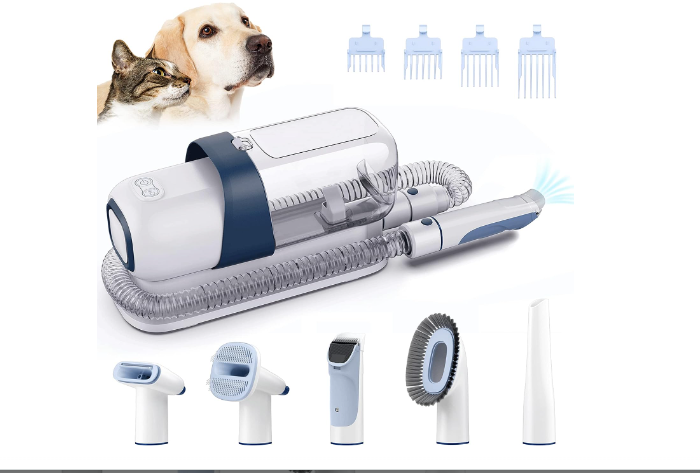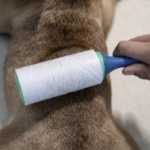Are you overwhelmed by your shedding dog’s grooming needs? Don’t worry – I’m here to help! I’m an experienced pet-owner who knows how to choose the best grooming supplies for shedding pooches.
Through this article, I’ll guide you through the process of understanding your dog’s fur type, choosing the right brush, identifying problem areas, and selecting the correct shampoo.
You’ll soon be an expert in proper aftercare for your shedding pup!
Key Takeaways
- Assess the condition of the undercoat to determine the type of brush needed
- Choose a brush that can penetrate thick undercoat or a softer brush for thin undercoat
- Consider the length of the fur when selecting a brush
- Deshedding tools help maintain a healthy coat and reduce shedding
Understand Your Dog’s Fur Type
Now that I know my dog’s shedding habits, it’s time to understand their fur type. It’s important to first assess the condition of their undercoat, as this will determine the type of brush I’ll need to use.
For example, if the undercoat is thick, then I’ll need a brush that can penetrate the coat and remove the loose hairs. If the undercoat is thin, then I’ll need a softer brush that won’t damage the delicate fur.
In addition, I’ll need to consider the length of the fur. If it’s short, then I’ll need a brush with stiffer bristles, while if it’s long, then I’ll need a brush with softer bristles.
By understanding my dog’s fur type, I can ensure I’m choosing the right brush and grooming supplies for my pup. This will help me keep their coat healthy and free of tangles and knots.
Now that I’ve identified my dog’s fur type, it’s time to choose the right dog brush.
Choosing the Right Dog Brush
I’m now choosing the right dog brush for my pup. Regular brushing is essential to help maintain a healthy coat and skin, as well as reduce shedding. It’s important to know what type of fur your pup has to pick the right brush:
- For short haired dogs, a pin brush is recommended to remove any tangles and loose fur.
- For longer haired dogs, a slicker brush is best for getting out mats and tangles.
- For double-coated breeds, an undercoat rake is best for removing the thick undercoat.
Each brush should be gentle enough to not hurt the pup’s skin, yet firm enough to help keep the coat healthy.
With proper coat care, regular brushing can help to reduce shedding and keep your pup’s coat looking great. This is an essential part of any pup’s grooming routine, and with the right brush, you’ll have a happy, healthy pup.
Now let’s move on to discussing deshedding tools.
Deshedding Tools
Having a shedding dog can be overwhelming, so it’s essential to have the right deshedding tools on hand. Deshedding tools are a great way to keep your dog’s coat healthy and help reduce shedding. Working together with deshedding techniques, you can groom your dog’s coat more efficiently.
When selecting deshedding tools, look for ones that are designed to remove loose hairs and fur without damaging your dog’s coat. Additionally, consider tools that can help you with coat trimming and fur removal.
To ensure you’re getting the most out of your deshedding tools, be sure to follow any instructions included with them. Additionally, take advantage of any grooming tips that can help you use the tools effectively.
With the right deshedding tools and techniques, you can help keep your dog’s coat healthy and reduce the amount of fur on your floors.
Identifying Shedding Problem Areas
In order to choose the best grooming supplies for your shedding dog, it’s important to identify problem areas and understand the different types of fur and shedding habits of different breeds.
To do this, it’s important to look at the breed of your dog, the type of fur they have, and their individual shedding habits.
Fur Types
Understanding the type of fur your dog has is essential to identifying the areas of your dog that may be prone to shedding. There are three main types of fur: short, medium and long. Short fur requires more frequent bathing methods, as it can easily become matted, while long fur needs more coat care to maintain its smoothness. Medium fur requires the most attention, as it needs to be brushed and groomed regularly to avoid shedding.
To keep your pup’s coat healthy and clean, here are a few tips:
- Regularly brush and groom your pup’s coat, depending on the fur type
- Bathe your pup as often as needed, using the right products for its fur type
- Use coat care supplies that are designed for your pup’s specific fur type
Shedding Habits
By identifying my pup’s shedding habits, I can pinpoint problem areas and choose the right grooming supplies. To begin, I’ll need to take into consideration my dog’s coat texture, thickness, and overall shedding patterns.
I can use a shedding blade to observe what kind of fur is coming off during the grooming process. This will help me determine the amount of fur my pooch is shedding each day and what type of grooming supplies may be necessary to address it.
Additionally, I should pay attention to any skin allergies that my pup may have. Any signs of redness or irritation should be a sign that I need to go for more specialized grooming products.
Breeds’ Needs
As a pet owner, I need to take into account the breed of my pup when choosing the right grooming supplies to address any shedding problem areas. Some breeds require more frequent bathing or grooming than others. Certain breeds may have fur that gets matted quickly and other breeds may have thicker coats that can be difficult to brush out.
Here are a few tips to help identify your pup’s specific needs:
- Assess the coat type: Does it require daily brushing or frequent bathing?
- Consider the grooming guidelines: Does the breed require special tools or techniques?
- Consider the bathing needs: Is your pup prone to dry skin or topical dermatitis?
Proper Grooming Technique
I’m going to show you how to properly groom your shedding dog.
Nail trimming is essential to ensure your pup’s paw health. Start by selecting the right clippers for the size of their nails. If it’s their first time, it’s best to have someone with experience there to help. It’s also important to provide plenty of positive reinforcement to ease the process.
Next, coat clipping is important to keep their fur in check. Begin by selecting the right clippers for their coat type. If your pup is fidgety, it can help to brush them first to get them used to the process. The key is to work slowly and be patient.
Lastly, always remember to finish with a petting session and heaps of treats – this will make sure your pup associates grooming with something positive!
Selecting the Correct Shampoo
When choosing the right shampoo for your shedding dog, the type of shampoo and the frequency of use are two important factors to consider.
It’s important to select a shampoo that’s specifically designed for dogs to ensure that the coat is being cleaned without any harsh chemicals that can be damaging to the skin.
You should also take into account how often your dog needs to be bathed and how often the shampoo should be used.
Type Choice
With so many types of shampoo available, it can be difficult to choose the right one for your shedding dog. When selecting the right shampoo, cost benefit analysis and health implications should be considered. Here are my top 3 tips to help you make the best decision:
- Do your research – read reviews and ask other pet owners for their recommendations.
- Consider the ingredients – select a formula that’s gentle on the skin and free of harsh chemicals.
- Be aware of the cost – while it may be tempting to choose the cheapest option, it’s important to consider the quality and how it will affect your dog’s health.
In the end, the key is to find the best balance between cost and quality. By carefully considering all of the factors, you can make an informed decision that will keep your pup’s coat healthy and looking its best.
Frequency Use
As a pet owner, I need to determine the frequency I should use a specific type of shampoo for my shedding dog. When bathing my pup, I should select a shampoo that’s specifically designed for their coat type. I should also pay attention to the bathing frequency of the product I choose.
In general, bathing a dog too often can strip its coat of natural oils, whereas bathing it too infrequently can cause skin irritation. I should also consider combing my pup’s hair with a specialized grooming tool the same frequency as the shampoo. This will help to remove any dead fur and prevent matting.
Ultimately, I should select a product that best meets my pup’s needs, and use it at the correct frequency. With proper care, my pup can have a healthy and beautiful coat.
Proper Aftercare for Shedding Dogs
After grooming my shedding dog, it’s important to take the proper aftercare steps to ensure its fur remains healthy and problem-free. A few important rituals to follow include regular baths, coat conditioning, and brushing.
Regular baths help to remove dirt and debris from the coat, as well as stimulate the skin and hair follicles for a healthy, clean coat. After bathing, make sure to properly rinse and dry your pup. It’s important to also condition the coat to keep it soft and healthy.
Brushing is an important part of the aftercare process, as it helps to disentangle the fur and remove any dead hair and dirt. It’s important to use the right type of brush for your pup’s coat type, and to brush in the direction of the fur’s growth.
Conclusion
Groom your shedding dog regularly to help keep their coat healthy and looking its best. Choose the right supplies for their fur type and make sure to pay attention to problem areas.
With the correct techniques and proper aftercare, you’ll be able to keep your pup’s coat in its best condition and help them feel confident and comfortable. Don’t be afraid to ask for help from a groomer or veterinarian if you’re unsure of how to best care for your dog.






